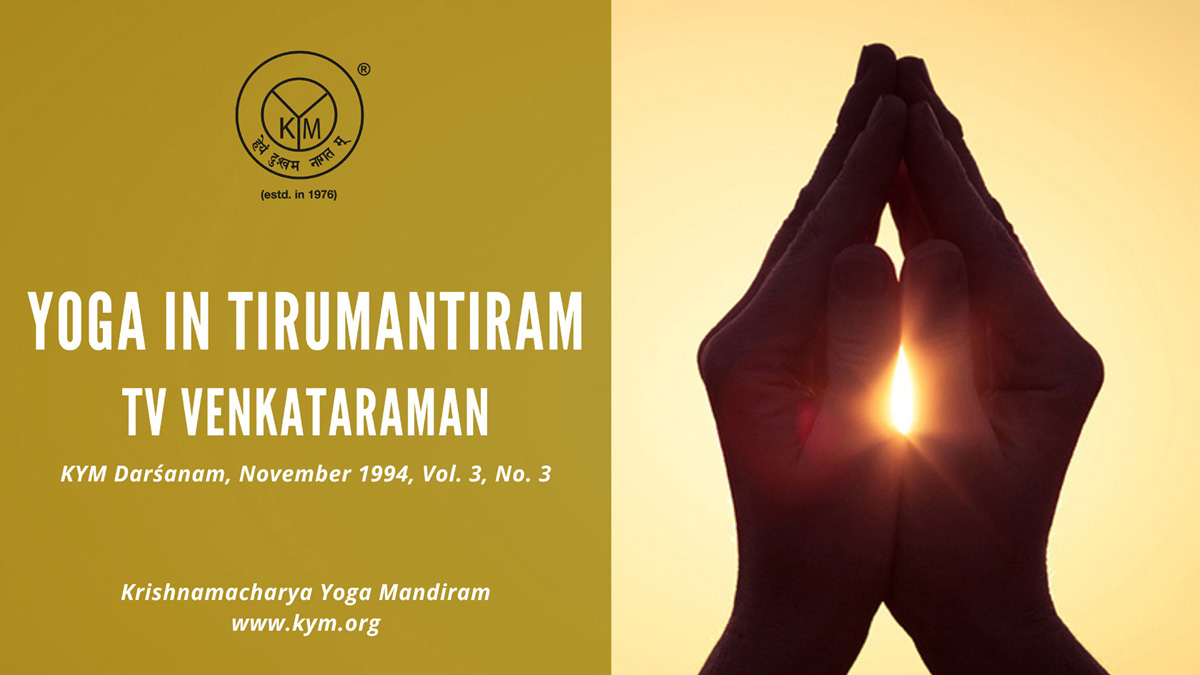TV Venkataraman
(Source: KYM Darśanam, November 1994, Vol. 3, No. 3)
In ancient India, while the tree of Saṁskṛtam flourished and sent out many branches, Tamil language and culture flourished independent of it and existed as a tree in itself. Among the many great works of Tamil literature, the Tirumantiram is one of the greatest. Singing the praises of Lord Śiva, it is second to none in the beauty of its poetry and the wisdom of its every word. It contains major insights on Yoga in addition to the various aspects of Śaivite philosophy and religion.
Saint Tirumūlar was a great Yogi and a realised soul who lived in the Himalayas. He came to the south of India to meet another great saint, Agasthya. Along the way, he had the Darśan of great Temples both in North and South India. It is said that at Chidambaram, he spent a few days in the company of Patañjali and Vyāghrapāda and finally reached a small village called Sathanur which is today a part of Tiruvaduthurai in Tanjavur district on the banks of the river Kaveri.
While approaching this village in the evening, he came upon the dead body of a cowherd which was surrounded by a number of cows shedding tears. Deeply moved by this touching scene and overcome with compassion for the animals, Tirumūlar is said to have hidden his body in a nearby tree and to have entered the body of the cowherd through Parakāyapraveśa, one of the eight Siddhi-s known to great Yogi-s. The cowherd, Mūlan, came back to life to the rejoicing of the animals. From this time on, he took the name of the cowherd and was henceforth known as Tirumūlar. He proceeded to the house of the cowherd, met the wife and made it clear that he was not the householder. He went to a nearby Maṇḍapam and sat there in Yogic trance for many years. The 3000 Mantra-s that he composed during this period, constitute the body of mystical knowledge called the Tirumantiramanimālai. This is the most comprehensive work in Śaivite literature and it covers all important aspects of Śaivite philosophy, religion, mysticism and Yoga.
Besides Saint Tirumūlar, there had been a number of mystic saints who had wandered the land singing the praises of Lord Śiva. These are the Nāyanmār-s of the Śaiva Siddhānta school, beginning from Kāraikkāl Ammaiyār and including Tirugnānasambandar, Tirunāvukkarasar, Sundaramūrti Nāyannār, Mānickavāssagar and a number of others. They poured their heart out in exquisite poetry which is today known as the Tevaram. The Tevaram and the Tirumantiram together constitute the very essence of the Śaiva Siddhānta philosophy of the Tamil people.
The Tirumantiram consists of nine Tantra-s and each Tantra sums up the philosophy and practice of one Āgama. Its nine Tantra-s represent the nine Āgama-s of the Śaiva Siddhānta school. The Āgama-s are the sacred wisdom given by Lord Śiva to Pārvatī when she, out of compassion for all mortals, asks him about Mukti (liberation), the path to it and the obstacles that would come in the way of its attainment. Tirumūlar says that these were numberless in the beginning but then got reduced to twenty eight. Of these twenty eight Āgama-s, Tirumūlar has given the quintessence of nine Āgama-s in the 3,000 Mantra-s that comprise the Tirumantiram.
In the Śaiva Siddhānta tradition, the Āgama-s occupy a position as high as the Veda-s. Tirumūlar has said that these two are not different from each other except in that the Veda-s are wider in their scope. The Āgama-s specify, for every aspiring soul, a form of worship, giving it a shape and meaning and lays down the procedure for its performance. They mark out the path to be followed for attaining Mukti. The four fold path of the Śaiva Siddhānta school comprises of the Carya, Kriyā, Yoga and Jnāna. The following of these will lead one to the ultimate goal of Mukti.
Yoga, is therefore an integral part of the Śaivite tradition. In fact, of the nine Āgama-s, the third Āgama is wholly devoted to Yoga. It is the Aṣṭāṅga Yoga of Patañjali that is dealt with, though with the difference that it speaks of Yoga as Śivayoga. Yama, Niyama, Āsana and Prāṇāyāma are called Kriyā Yoga and Dhāranā, Dhyāna and Samādhi together constitute Antaryoga. Pratyāhāra is where the Antaryoga begins; whereas Patañjali outlines the goal of Yoga to be the control of the mind’s activities, Tirumūlar goes on to add that it is the control of the mental activities with a view to their concentration on Śiva, ultimately leading to a state of oneness with Him.

The scheme of Yoga in the Tirumantiram presupposes a feeling of great love towards the Lord. It is made very clear that without Bhakti, Yoga is of no consequence. In fact, Tirumūlar refers slightly to those whose goal is to twist their limbs in a thousand ways. He says that if the heart is not full with love for the Lord, all this is useless. Nalluzhakam is a Tamil word which describes the life of a Yogi. It can be translated as ‘good conduct’ but actually denotes vastly more. It includes a life of purity, austerity, devotion to the Lord and compassion towards fellow beings. This is the foundation for a Yogic life and other practices are to aid and strengthen this lifestyle.
Great importance is given to Prāṇāyāma and Tirumūlar devotes many verses to describing in detail the techniques for the control of Prāṇā and the many benefits that accrue from it. In the portions dealing with Dhyāna and Samādhi, Tirumūlar makes it very clear that control of the Prāṇā leads to control of the mind.
Dhyāna is called Yogattil Yogam, the Yoga of Yoga-s. It is a state of continuous awareness in the supreme intelligence leading to a state of oneness with it (Samādhi). In the later day commentaries to the Tirumantiram, Dhyānam has been represented by the individual soul being filled with divinity and Samādhi as the swallowing of the individual soul by the divine. In Śaiva Siddhānta philosophy, the individual soul is always different from Godhead. In Dhyānam, there is the experience of the individual soul and a correct understanding of its position in relation to the divine intelligence. In Samādhi, there is the experience of oneness with Lord Śiva himself due to which there is no awareness of the individual soul.
Devotion and worship are essential features of Śaiva Siddhānta philosophy and are constantly emphasised throughout the Tirumantiram. The worship of Śiva can be in any of three ways
- Uruva worship,
- Arurva worship or
- Aruva
Uruva worship is in terms of images, Arurva worship is of the Śivaliṅga which comprises both the concrete form and the concept it represents and the Aruva worship is the highest level of worship contemplated by the great saints.
Finally, two important features of the Tirumantiram are:
- First, that its path is open to all who approach the Lord with sincerity and devotion,
- Second, the grace of the Lord is obtained or bestowed only through the grace of the Guru.
TV Venkataraman was a former Chief Secretary to the Government of Tamil Nadu and is also a well-known scholar of Tamil literature and especially of the Tirumantiram.

